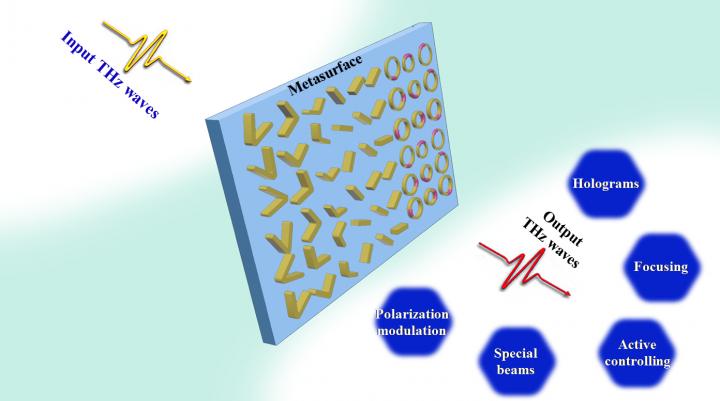Metasurfaces for manipulating terahertz waves

The associated THz responses include focusing, holograms, polarization modulation, special beams and active controlling.
Credit by Xiaofei Zang, Bingshuang Yao, Lin Chen, Jingya Xie, Xuguang Guo, Alexei V. Balakin, Alexander P. Shkurinov, and Songlin Zhuang
THz waves have a plethora of applications ranging from biomedical and medical examinations, imaging, environment monitoring, to wireless communications, because of the abundant spectral information, low photon energy, strong penetrability, and shorter wavelength. THz waves with technological advances not only determined by the high-efficiency sources and detectors but also decided by a variety of the high-quality THz components/functional devices.
However, traditional THz devices should be thick enough to realize the desired wave-manipulating functions, hindering the development of THz integrated systems and applications. Although metamaterials have been shown groundbreaking discoveries due to the tunable electric permittivity and magnetic permeability of a meta-atom, they are limited to technical challenges of fabrication and high loss of the metal-based unit cell.
In a new paper published in Light: Advanced Manufacturing, a team of scientists, led by Professor Songlin Zhuang from Terahertz Technology Innovation Research Institute, University of shanghai for Science and Technology, and co-workers have summarized the recent advancements of metasurfaces for the manipulation of THz waves. These ultra-compact devices with unusual functionalities render metasurface devices very attractive for applications such as imaging, encryption, information modulation and THz communications.
Actually, metasurfaces typically consist of planar antennas that enable predesigned EM responses. The antennas are made by metals or traditional high-refractive index dielectrics that can be easily fabricated based on the standard fabrication process. In addition, metasurfaces with the functionality in manipulating EM waves are dependent on the abrupt phase changes at planar antenna interfaces, and thus the thickness of metasurfaces is much thinner than the incident wavelength. Metasurfaces can locally control the wavefront of EM waves at subwavelength resolution, leading to various practical applications such as metalens, waveplates, vortex beam generators, beam steering and holograms. The ultrathin nature of metasurfaces, the ease of fabrication, and the subwavelength resolution in manipulating of EM waves make metasurfaces ideal candidates for THz device miniaturization (ultra-compact THz devices) and system integration.
The metasurface-based approach for manipulatig THz waves enables remarkable contributions in designing ultra-thin/ultra-compact and tunable THz components. The main advantages/contributions of THz metasurfaces can be concluded as follows: (1) THz components with reduced size: The functionalities of focusing, OAM, and polarization conversion realized by metasurfaces can be traditionally obtained by using a THz lens, helical phase plate, and half-wave (or quarter-wave) plate, respectively; (2) THz components with multiple functions: The traditional THz devices, e.g. THz lenses, waveplates, etc…, are always show a single function. Metasurfaces not only provide a flexible platform to realize ultra-thin/ultra-compact THz devices with single function, but also enable the unprecedented capability in designing multifunctional THz devices. (3) THz components with tunable function: Metasurfaces combined with VO2, graphene, etc, open a new avenue for designing THz components with active functions.
In conclusion, metasurfaces with planar structures can locally modify the wavefront of THz waves at subwavelength resolution. Metasurfaces not only provide an ultra-compact platform for manipulating the wavefront of THz waves, but also generate a plethora of applications that are difficult to achieve with conventional functional devices. As an overview, the recent developments of metasurfaces for manipulating THz waves were presented in this paper, and this progress report may open a new avenue to design ultra-thin or ultra-compact THz functional devices and systems.
Media Contact
All latest news from the category: Physics and Astronomy
This area deals with the fundamental laws and building blocks of nature and how they interact, the properties and the behavior of matter, and research into space and time and their structures.
innovations-report provides in-depth reports and articles on subjects such as astrophysics, laser technologies, nuclear, quantum, particle and solid-state physics, nanotechnologies, planetary research and findings (Mars, Venus) and developments related to the Hubble Telescope.
Newest articles

Innovative 3D printed scaffolds offer new hope for bone healing
Researchers at the Institute for Bioengineering of Catalonia have developed novel 3D printed PLA-CaP scaffolds that promote blood vessel formation, ensuring better healing and regeneration of bone tissue. Bone is…

The surprising role of gut infection in Alzheimer’s disease
ASU- and Banner Alzheimer’s Institute-led study implicates link between a common virus and the disease, which travels from the gut to the brain and may be a target for antiviral…

Molecular gardening: New enzymes discovered for protein modification pruning
How deubiquitinases USP53 and USP54 cleave long polyubiquitin chains and how the former is linked to liver disease in children. Deubiquitinases (DUBs) are enzymes used by cells to trim protein…


